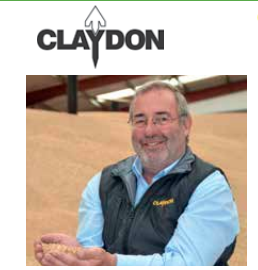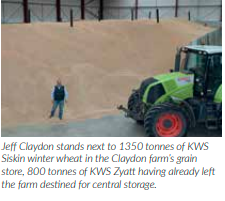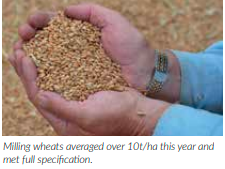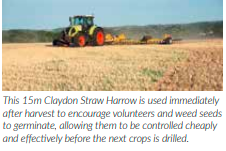COST PER TONNE OF PRODUCTION MUST BE THE KEY DRIVER

The 2019 harvest yielded excellent results on the Claydon farm, resulting in a cost per tonne of production which provided a good margin, says direct strip seeding pioneer Jeff Claydon, who designed the Claydon Opti-Till® System.
In Issue 6 of Direct Driller magazine I discussed the importance of healthy soils and how to achieve them. This time, I want to reflect on the 2019 harvest and look ahead to autumn drilling, our goal now being to ensure that next year’s crops get off to the best possible start. Here in the East of England we have been very fortunate with the weather and at the time of writing this (20 August) we are over half-way through harvest, which has been relatively straight forward. However, I realise that has not been the case in many other areas of the country and sympathise with those affected.

Last year, despite the three-month drought, we enjoyed good yields, with milling wheats averaging over 8.5t/ha and £190/t. Yields are significantly higher this year, with oilseed rape averaging over 4.5t/ha despite coming under extreme pressure from Cabbage Stem Flea Beetle (CSFB) and milling wheats over 10t/ha. I am delighted that so that many of our customers have taken the time to call our office to report that they have done even better, equalling or improving on our performance, in some cases with average yields of over 12 t/ha. They deserve to be congratulated. The downside this year is oversupply and wheat is currently trading at around £130/t. At that level many farms which continue to use a traditional, high-cost establishment system will be making a significant loss on every tonne produced.
FOCUS ON COST PER TONNE
With added pressure caused by fears over possible tariffs and the uncertainties surrounding Brexit every farming business must aim to produce crops at the lowest cost per tonne. However, it would be disastrous simply to cut costs only for yields to fall, as that would negate any benefit.

For example, some might look to cut out a fungicide, or reduce the rate, but that would be a dangerous tactic as every single one that we used last season paid off, even when no signs of disease were evident. We also found substantial benefits to milling wheat proteins where higher rates of nitrogen were used. Assuming it is possible to accurately measure yields, I would certainly recommend that every farm has at least one tramline dedicated to experimenting with different rates of nitrogen and fungicides.
Going forward, the key must be to operate a system which is proven, enables crops to be produced with equal or better yields, and generates a healthy, sustainable profit margin. Those who purchase a direct drill solely to cut costs and expect instant results without investing time to understand how it works and how to get the best from it, will inevitably be disappointed. Before investing, it is vital to understand the fundamental differences between the various types and makes of direct drill, with harvest results providing the acid test of their capabilities.
On our own and contract farms we naturally use the Claydon OptiTill® System, a holistic approach to crop establishment which has been independently proven, over 16 years, to consistently produce high-yielding crops at very much lower cost than where either conventional plough-based or mintill systems are used, providing maximum profitability.
A good harvest represents the culmination of making the right choices throughout the season and we must address each field individually, understand any issues it might have and tailor our approach accordingly. Correct establishment is crucial to getting the best results from autumn and spring sown crops and is a subject that I have covered in previous issues of Direct Driller magazine.
A GOOD YEAR FOR STUBBLE MANAGEMENT
The damp weather during harvest has made compaction a major issue on many farms this year and in some cases the damage inevitably inflicted by combines, grain trailers, balers and other harvest machinery will be difficult to repair by cultivations alone. Trying to do so will over-work soils and exacerbate the situation, making them more prone to weather risk, erosion and slumping, resulting in poor crop performance.

Compaction can take years to repair and can adversely affect crops established using low-disturbance drills, which will be reflected in yields next harvest. Depending on the depth of the compaction, investigation should be done to ascertain the extent of the problem and appropriate remedial action taken. If compaction is found below the working depth of the leading tine on the Claydon Hybrid drill then subsoiling should be considered, particularly if you are new to the Claydon Opti-Till® System. Once it has been used then the drill’s leading tine usually works deep enough to eliminate any shallow compaction, providing excellent rooting for the new crop, which is key for plant development and to optimise yields.
Generally, this is not an issue with the Claydon Opti-Till® System because the patented leading tines on the Hybrid drill remove surface compaction as part of the drilling process, levelling the surface and ensuring that the seeding zone provides just the right growing conditions for the new crop to germinate quickly and grow away unhindered. In turn, this means less competition from volunteers and weeds, so inputs are used more efficiently and fully benefit the crop.
If your soils are in excellent condition and worm counts are at high levels, then the crops will also be right. As soils become healthier and more productive weeds and volunteers will naturally take advantage of the improved growing conditions. The reason that they sometimes appear to be less of a factor with low-disturbance or zero-disturbance establishment systems is simply that soils are in far from ideal condition because of compaction or because they can become anaerobic, with significant adverse effects on the crop. We all must play the cards that Mother Nature has dealt us, but the secret is to play those right cards at the right time and in the right order. Rather than following a prescriptive approach to farming, just because ‘that’s the way it has always been done’ we tailor our approach to the season, the key being to have a good rotation and avoid over-cultivating the soils.
The damp weather in August may have delayed combining on occasions, but it has provided ideal conditions for an effective stubble management programme. It is essential to encourage volunteers and weed seeds to germinate quickly so that they can be removed before the next crop is drilled, because it is much more efficient and cost-effective to deal with them at that stage rather than in the growing crop. Soil conditions this year are the opposite of those in 2018. Instead of containing zero moisture, soils are very moist, so we have adapted our approach accordingly. Slugs love wet conditions and wet trash, so a few can quickly become many if not dealt with effectively.
Immediately after oilseed rape had been combined, we used our 15m Straw Harrow to create a shallow surface tilth and followed that with the TerraStar light rotary cultivator to create a little more soil movement. This resulted in a carpet of OSR volunteers which were left in the hope that they would retain any remaining Cabbage Stem Flea Beetles and discourage them from migrating into next year’s crop, which was drilled on 9 August and five hours later received 15mm of rain, so it got away well.
When the new crop reaches the four-leaf stage and is better able to withstand CSFB attack, we will take out the OSR catch crop with the TerraStar and then clean up any volunteers with full-rate glyphosate before drilling winter cereals. It will be important not to let the volunteer OSR become too dense and give grassweeds the opportunity to flourish, but should that happen, or slugs begin to proliferate, we will hit them again with the Straw harrow or TerraStar.
The loss of neonicotinoid seed treatments and some products to control grassweeds creates a fear that the aphid vectors of Barley Yellow Dwarf Virus (BYDV) will increase significantly. This can be reduced considerably by using the Opti-Till® system to manage stubbles and take away the green bridge effect. You can also delay drilling, but to do that with any degree of certainty you must be able to get the crop in the ground quickly, which means not having too many operations before sowing. A key benefit of the Claydon System is that its high output potential provides much greater flexibility, so you can choose when to drill rather than having to press on regardless. That is very important because we don’t want the hassle and weather risk which ploughbased or min-till systems create due to the need to prepare seedbeds well in advance of drilling.

We do that by implementing OptiTill’s effective stubble management programme, followed by a robust application of glyphosate to tidy up any stragglers that might be left. The aim is to create a 3cm deep stale seedbed, certainly no more than 5cm, especially when working with clay soils which need to dry before following operations, so we only use the Straw harrow and TerraStar when conditions are right. When drilling with the Claydon Hybrid we recommend 50hp-60hp per metre of drill width, not to go deep but to comfortably maintain an operating speed of 10 – 12 km/h, giving very high outputs and ultimate flexibility. In my next article I will review the performance of our autumn-drilled crops and look ahead to what we have planned for the spring.
To learn more about the Claydon OptiTill® System and techniques to improve your farm’s performance contact your local Claydon dealer and arrange a visit to the Claydon farm. For further details go to www.claydondrill.com or call the Claydon office on 01440 820327.